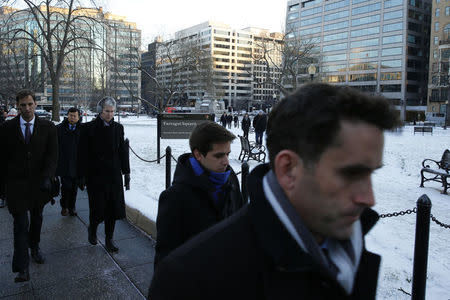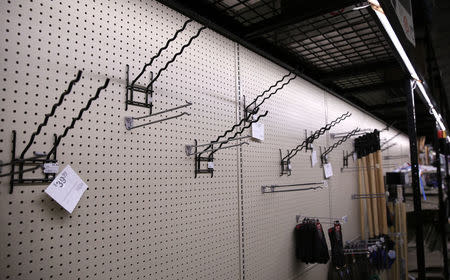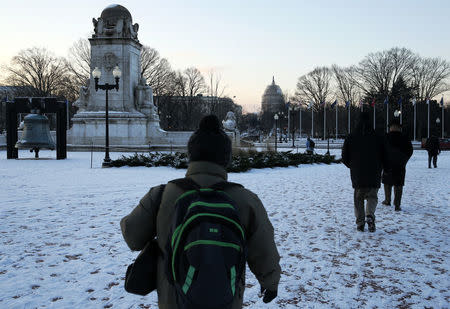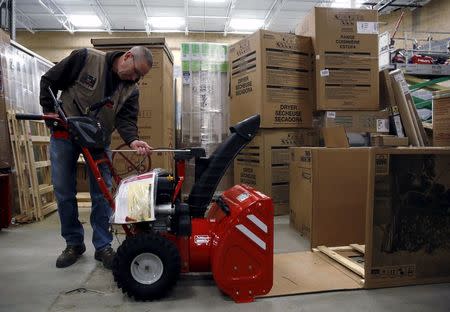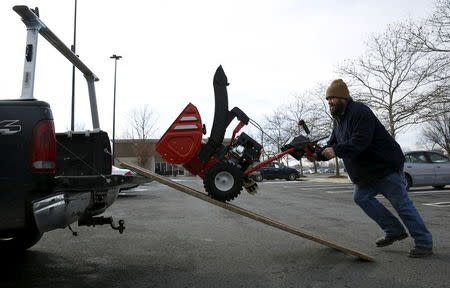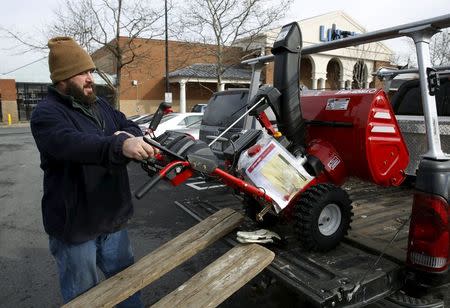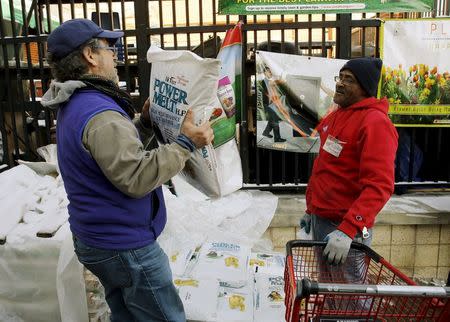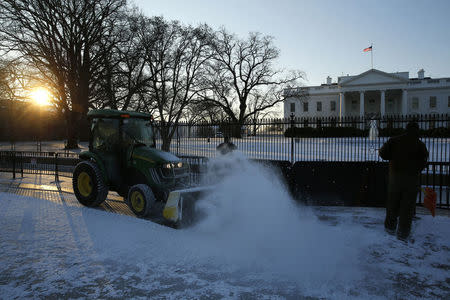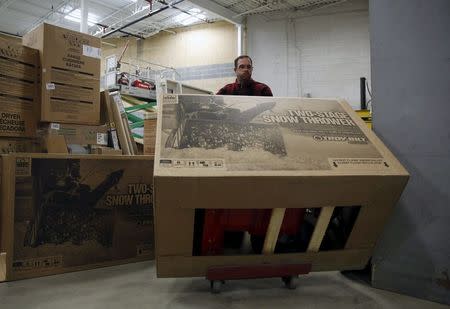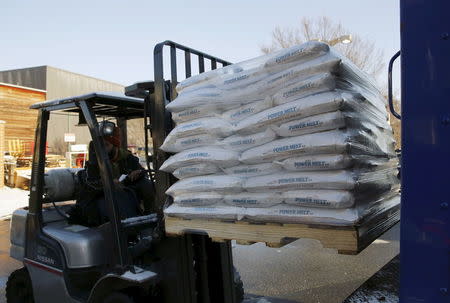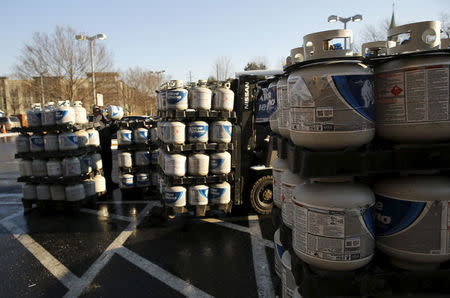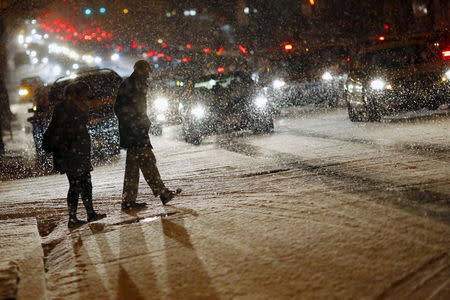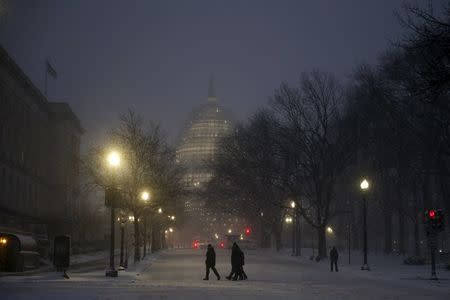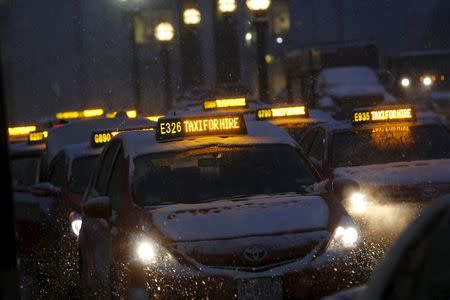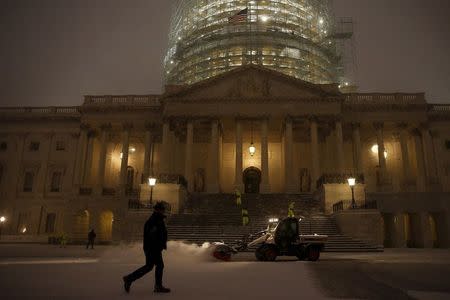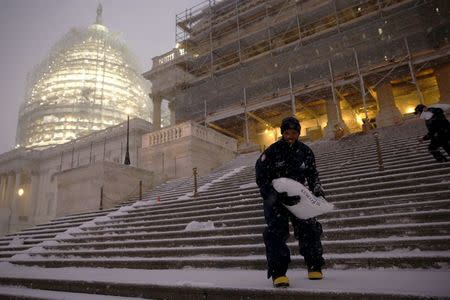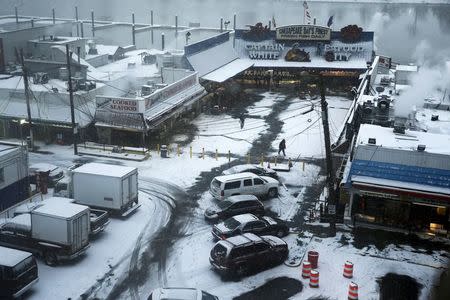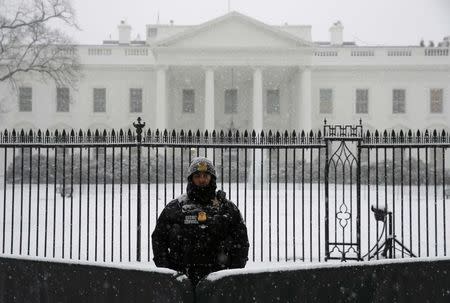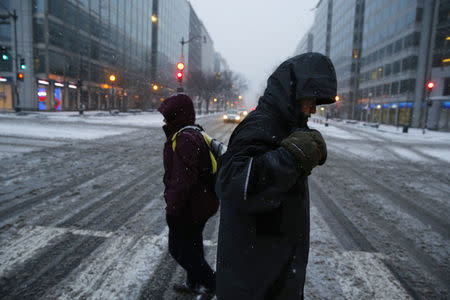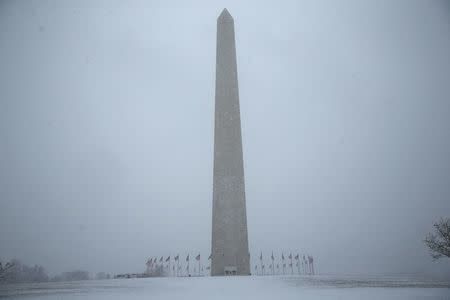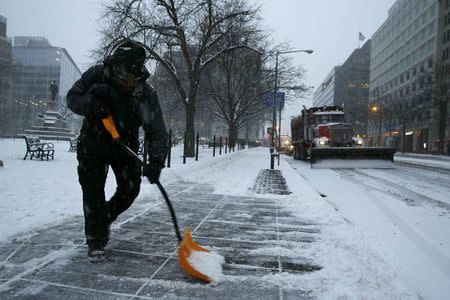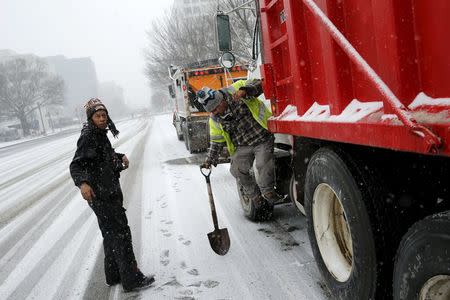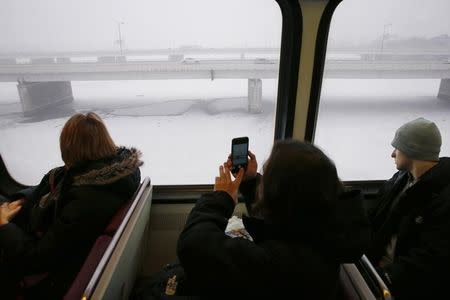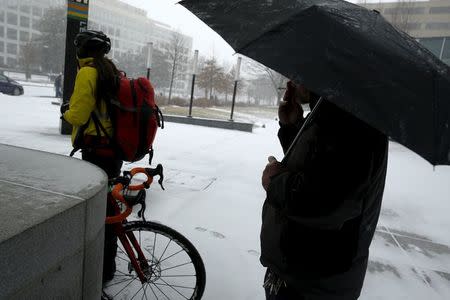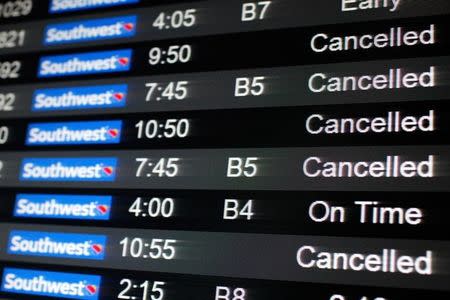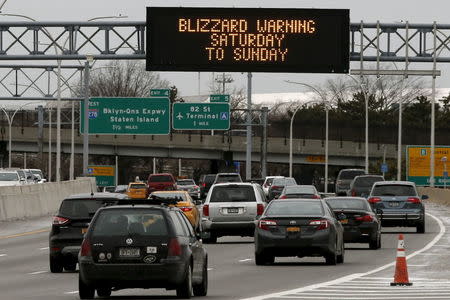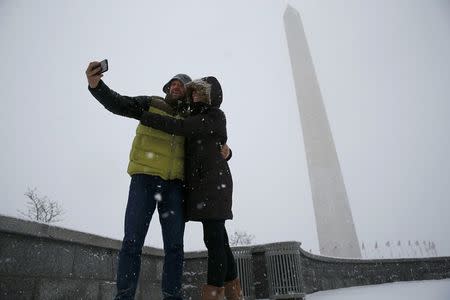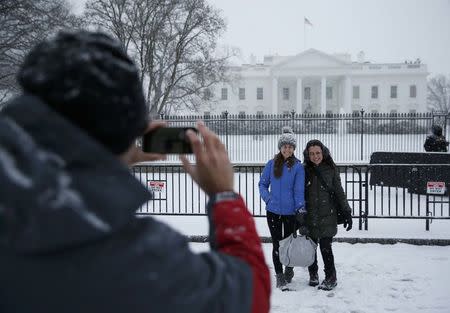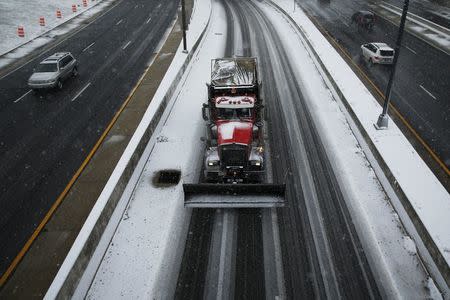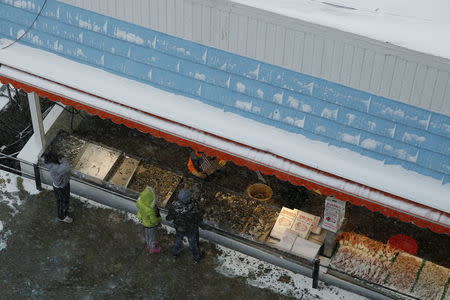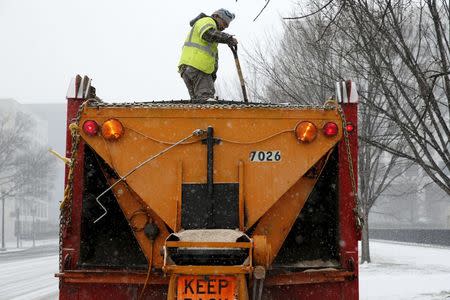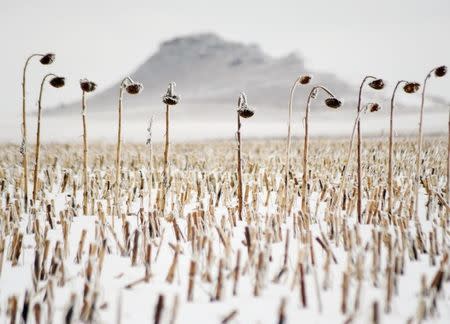East Coast blizzard bids for place in Washington DC history
By Ian Simpson WASHINGTON (Reuters) - A winter storm that could bury parts of the U.S. Middle Atlantic region under nearly three feet of snow slammed into Washington, D.C. on Friday afternoon, threatening the nation's capital with record accumulations as it barrels up the populous East Coast. After emergency officials planned and residents scrambled for days to stock up on supplies, the blizzard started to blanket the Washington area during the early afternoon after six people had died in car crashes as a wintry mix spread across Arkansas, Tennessee and Kentucky. The storm could dump two to two and a half feet (61 to 76 cm) of snow on the capital and bring winds of 30 to 50 mph (48 to 80 kph) before winding down late on Saturday afternoon, according to the National Weather Service. By then it would have moved over Philadelphia and New York, bringing 12 to 18 inches (30 to 46 cm) of snow. Washington's western suburbs may get up to 3 feet (91 cm), forecasters said. In Falls Church, Virginia, about 8 miles (13 km) west of the capital, a thick curtain of snow was already piling up on the deserted streets on Friday evening, creating a peaceful tableau that may have disguised dangerous conditions to come. "I want to be very clear with everybody. This is a major storm," Washington Mayor Muriel Bowser said as the city braced for what could turn out to be one of the worst storms in its history. "This has life-and-death implications and all the residents of the District of Columbia should treat it that way." Six fatalities have been reported so far in weather-related car crashes as of Friday afternoon. Four were in North Carolina and one each in Arkansas and Tennessee. The Weather Channel said more than 85 million people in at least 20 states were covered by a winter weather warning, watch or advisory. Airlines canceled nearly 6,300 flights for Friday and Saturday, most at airports in the New York and Philadelphia areas, according to flight tracking website FlightAware.com. Washington's snowfall could eclipse the "Snowmageddon" storm of 2010 that dropped 17.8 inches (45.2 cm), AccuWeather senior meteorologist Alex Sosnowski said. If forecasts prove accurate, the storm could rival the 1922 Knickerbocker storm, which dumped a record 28 inches (71 cm) on the city. "I think it’s going to be a nightmare, the rates of snow we’re talking about," said Marisa Kritikson, 27, a nursing student at George Washington University in Washington after buying a snow shovel to dig out from her basement apartment. New York Mayor Bill de Blasio asked people to limit travel to "absolute emergencies" as he declared a winter weather emergency for the largest city in the United States. "There will be white-out conditions," he told a press conference ahead of the storm, which is expected to hit the city after midnight. New York accumulations could reach up to 18 inches (46 cm), with winds gusting to 50 miles per hour (80 kph), whipping up blizzard conditions. Southeastern Pennsylvania, including Philadelphia, was expecting 10 to 18 inches (25 to 46 cm). The approaching storm led New Jersey Gov. Chris Christie to come home from New Hampshire, where he is vying for the Republican presidential nomination. Residents along New Jersey's coast prepared for potential flooding during high tides on Saturday and Sunday. In Ocean City, emergency management officials warned of forecasts calling for the highest flood levels since Superstorm Sandy brought heavy damage in 2012. High winds and a full moon could combine to create a high tide of nearly 8 feet (2.4 meters) in Atlantic City, officials said, still shy of the 10 feet (3 meters) that Sandy caused in Ocean City. In New York, the National Weather Service issued coastal flood warnings for the boroughs of Staten Island, Brooklyn and Queens as officials prepared for possible evacuations from low-lying areas. Post-Sandy reconstruction has put the area in a stronger position to face the storm, New York Governor Andrew Cuomo said. SCRAMBLE FOR SUPPLIESThe storm arrived in the Washington area, home to about 6 million people, after dropping 5 inches (13 cm) of snow in Arkansas and spreading a wintry mess of snow, sleet and freezing rain in parts of Tennessee and Kentucky. In addition to several inches of snow, the Charlotte, North Carolina, area could get up to a half inch (1.3 cm) of ice, causing concerns about power outages and dangerous driving conditions, officials said. Other parts of the state could get a foot of snow. Federal offices in the Washington area closed at noon on Friday to allow employees to get home before the snow began piling up. City officials said everyone except emergency workers should stay off the streets. Many residents had scrambled to prepare ahead of the storm, picking stores clean of bottled water, food and other supplies. "I have nine cases of wine, half and half and coffee, firewood and all my devices are charged. All I need now is a wing and a prayer,” said Liz Scherer, 54, who works out of her home in the Washington suburb of Silver Spring, Maryland. The Washington Metropolitan Area Transit Authority, which includes the second-busiest U.S. subway system, took the rare step of suspending operations from late Friday through Sunday. The Metropolitan Transportation Authority, which operates New York City subway and commuter rail lines, expected to operate normal service, Cuomo said, as did New Jersey Transit. The forecast prompted the Virginia National Guard to bring in about 300 troops to deal with emergencies. In New York, 600 National Guard personnel were on standby. (Additional reporting by Colleen Jenkins in Winston-Salem, N.C., Suzannah Gonzales in Chicago, Barbara Goldberg and Joseph Ax in New York, Susan Heavey in Washington, Lacey Johnson in Silver Spring, Md., Steve Barnes in Little Rock, Ark. and Harriet McLeod in Charleston, S.C.; Writing by Frank McGurty; Editing by Diane Craft and James Dalgleish)
